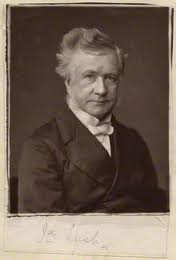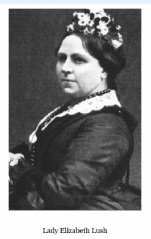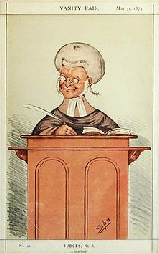Lush, Rt. Hon. Sir Robert (1807-1881)
From The Annual Register 1881 - Chronicle p. 153-4
27th December – at Avenue Road, Hampstead aged 74 – Rt. Hon Sir Robert Lush, a Lord Justice of Appeal who was born in October 1807 at Shaftesbury. His father was Mr. Robert Lush of that town, and his mother was Lucy, the daughter of Mr. Foote of Tollard, Wiltshire. In his 29th year he was admitted student of Gray's Inn. His previous experience, and especially his practical familiarity with the ministerial business of Judges Chambers, enabled Mr. Lush from the first to earn high distinction as a student; and it was in his student days that he published the first work with which his name is associated. In 1838, two years before his call, he published the Act for the Abolition of Arrest on Mesne Process (1 & 2 Vict 1 & 2) with copious notes explanatory of the alterations in law and practice effected thereby and an Index. Its success encouraged Mr. Lush to publish in 1840 his more famous work Practice of the Superior Courts of Common Law at Westminster in Actions and Proceedings over which they have a Common Jurisdiction On being called to the Bar by his inn in November 1840, Mr. Lush joined the Home Circuit, and practised as a special pleader within the Bar. His deserved reputation as a sound and acute lawyer, specially familiar with procedure, but not wanting in acquaintance also with the substantive body of the law, brought him early into practice. In 1857 he was made a Q.C., and immediately elected a bencher of his Inn. He practised as leading counsel for eight years, and, though he never held any official status, and never had a seat in Parliament, he was for his professional merits alone selected as successor of Mr. Justice Crompton and received his patent as a Justice of the Queen's Bench on the 30th October 1865. Mr. Justice Lush was knighted in due course. In a judicial career of 16 years Sir Robert Lush presided at many important investigations. Sitting in the same court with Sir Alexander Cockburn and Sir Colin Blackburn he was constantly appealed to on the points of practice and judicial discretion which make up a most important part of the duty of all courts of law. Perhaps he came most prominently before the public as one of the three Judges of the famous trial at the Bar of Thomas Castro, otherwise Arthur Orton, for perjury and forgery in supporting his claim to the Tichborne estates. A remarkable opportunity of utilising Sir Robert Lush's extensive knowledge of practice was afforded by the framing of the rules under the Judicature Act, which he is credited with having most powerfully helped to mould, in association with Sir George Jessel, the one representing the experience of Common Law and the other that of Equity. He had been sworn a member of the Privy Council in 1879. Sir Robert Lush served on many Commissions and Committees of Judges. One of his latest tasks was to consider Sir James Stephen's well-known draft code relating to indictable offences. He married in 1839, Elizabeth Ann, eldest daughter of the Rev. Christopher Woollacott of London.


From Li ke Father like Son: The biographies of Lord Justice Robert Lush and his son Sir Charles Montague by Baron Lush with his kind permission
ke Father like Son: The biographies of Lord Justice Robert Lush and his son Sir Charles Montague by Baron Lush with his kind permission
However, just as the Rev Woollacott had made his mark at Westminster for nine years, Robert had also made his on the minister's family. Despite the fact that his eldest daughter apparently had several other suitors, it was Robert who both attracted and held Elizabeth's attention. 'She was but short in stature, with striking dark eyes, and he used to tell his children that he fell in love with those brown eyes then and there,' says Dorothy Pearce Gould, one of Robert and Elizabeth's granddaughters, in her charming little book Diamonds in Drummond Street reverently dedicated to her mother and grandmother. It was at this chapel that both Robert and Elizabeth were baptized by her father and the following extract is taken from a moving account by one of Elizabeth's relatives:
When the minister resigned his post at Westminster in 1834 for a trial year at another beleaguered chapel in Little Wild Street, Lincoln's Inn Fields, Robert also transferred his congregational allegiance. But exactly when he moved into lodgings with the Woollacotts is not certain. The dates we do have are as follows: in 1834, the Woollacotts moved to Little Wild Street; on the 16th November, 1836, Robert entered himself as a student at Gray's Inn; and, on the 6th April, 1839, Robert married Elizabeth at St Pancras Old Church. Reade's account of Robert's activities compresses the sequence of events as follows:
'He was a Baptist and lodged with a Baptist minister and his two daughters. He fell in love with one of them, proposed to her and was accepted. The couple were married without pomp and, after the ceremony, the good minister took them aside and said, 'I have only £200 in the world; I have saved it a little at a time, for my two daughters. Here is your share, my children.' Then he gave his daughter £100 and she handed it to the bridegroom on the spot. The good minister smiled approval and they sat down to what fine folk call breakfast, but they called dinner, and it was.
After dinner and the usual ceremonies, the bridegroom rose and surprised them a little. He said, 'I am very sorry to leave you but I have a particular business to attend to; it will take me just one hour.' Of course there was a look or two interchanged, especially by every female there present, but the confidence in him was too great to be disturbed and this was his first eccentricity. He left them, went to Gray's Inn and put down his name as a student for the Bar. He then paid away his wife's dowry in the fees and returned within the hour. Next day the married clerk was at the office as usual and entered on a twofold life. He worked as a clerk till five, dined in the Hall of Gray's Inn as a sucking barrister and studied hard at night…'
Click to return to the main tree

Sir Robert and Lady Lush
